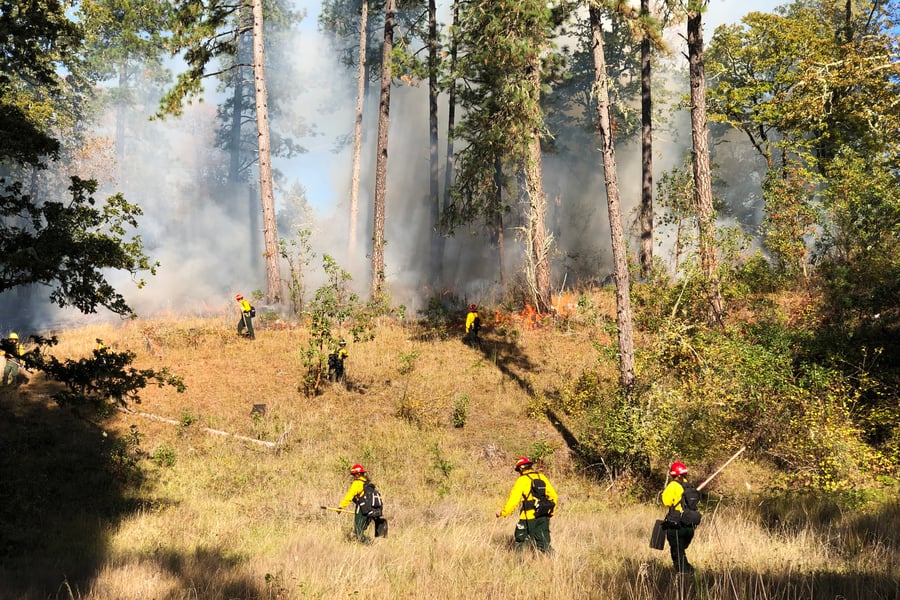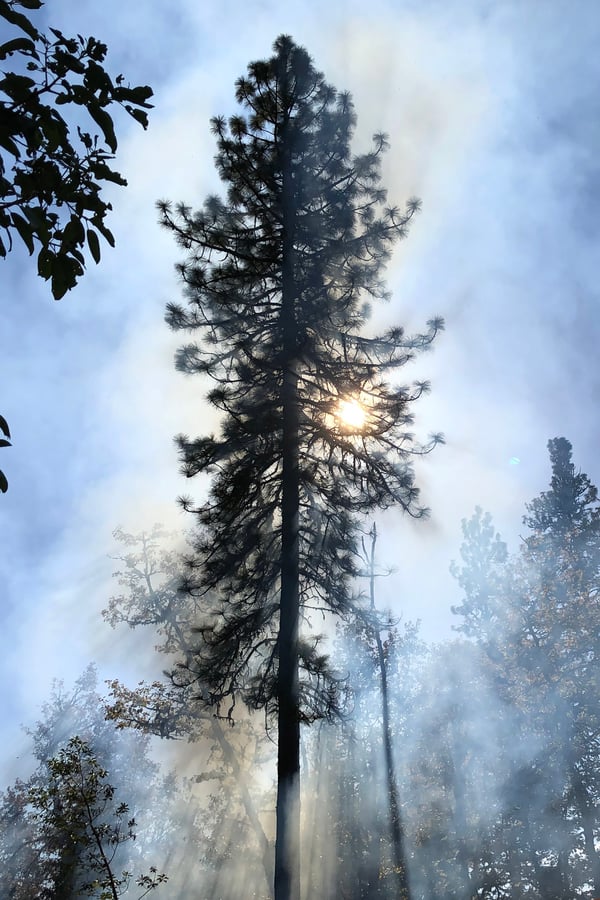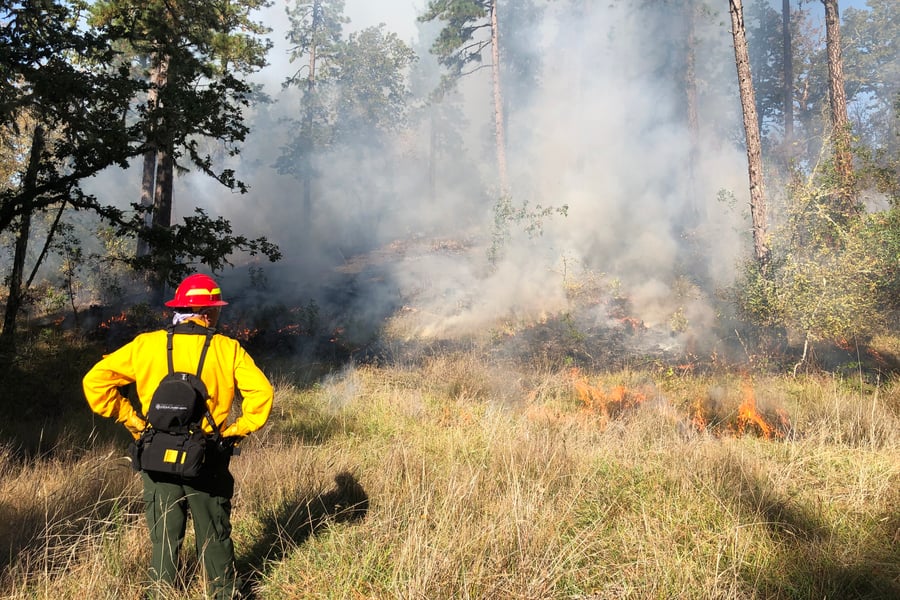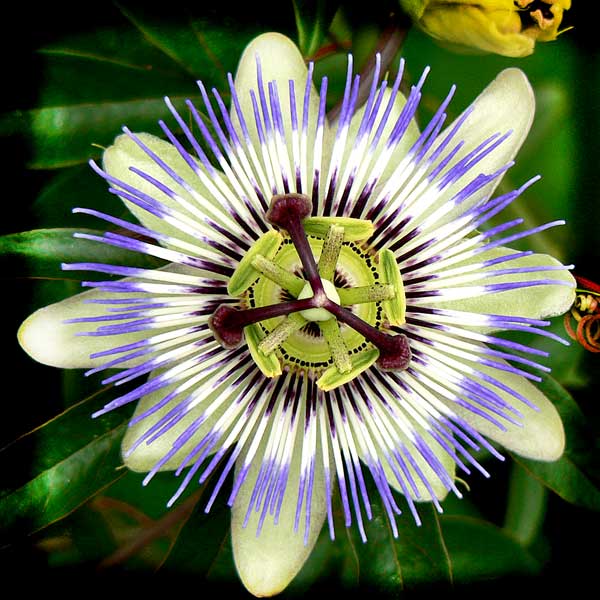On a warm October afternoon in 2021, roughly 40 personnel from Oregon forest agencies, area tribes, and conservation groups, including the Long Tom Watershed Council, gathered on the Andrew Reasoner Wildlife Preserve outside Eugene. Among them were a dozen Native American firefighter trainees who had spent the week learning the essentials of wildfire suppression. That the culmination of their training would be the deliberate burning of an eight-acre parcel of land might strike some as contrary, even outrageous. As a former National Park Ranger who served as a firefighter in the early 90s, this certainly flew in the face of the training I’d received.
 Photograph by Brian Bull.
Photograph by Brian Bull.
At that time, the overarching federal and state policy was the complete and total suppression of wildfires: the continuation of an approach begun a century earlier as the U.S. Forest Service asserted its management of vast acreages of timber and recreational sites. In the public’s view, it was a sensible and valiant policy, further popularized by the stoic Smokey the Bear who reminded everyone that “Only you can prevent forest fires.” But there was much missing from the overall picture, and only recently have perspectives on wildfire management begun to shift to a more sensible strategy.
Among the trainees at this deliberate burn was a Klamath Modoc tribal member named Derek Kimbol. He told me that fire was essential to the landscape. Before colonization, Native women burned stands of huckleberries—called iwam—every four years. Minutes later, clad in a hard hat and green and yellow fire-retardant fatigues, Kimbol gave a prayer of gratitude to the Creator, then ignited his drip torch. He began spreading hungry orange flames in a controlled line that used part of an existing dirt road for containment. In a different era, Kimbol would have been prevented—even hauled off to jail—for this deliberate action. But in this age of global warming and constant dry conditions, this “cultural burn” is gaining acceptance.
 Photograph by Brian Bull.
Photograph by Brian Bull.
An Oregon Department of Forestry representative, Caitlin Johnson, told me that with fires getting bigger and moving more quickly, management practices of the past century weren’t feasible anymore. “I think, moving forward, the discussions of prescribed burns are only becoming more frequent. And they are being utilized both on the Forest Service lands and state lands, especially in the last five years,” she said.
For Native Americans and other Indigenous practitioners of cultural burns, this turnaround is a long-awaited vindication of ancient values. Throughout the day, fire crews and representatives of Oregon State University and the Ecostudies Institute discussed and practiced how to use fire effectively. By day’s end, the targeted acreage was a blackened patch flanked by roads and a few trails, with the trainees and agency officials sharing a communal salmon dinner.
Forests across the U.S. have trees that depend on fire to reproduce. From the spindly lodgepole pine (used by Indigenous people for tipis and longhouse shelters) to the towering giant Sequoia, the presence of fire has allowed them to release their fire-activated seeds. During another controlled burn at the Smithfield Oaks near Dallas, Oregon this summer, Marc Bell of the Polk Soil and Water Conservation District told me that the once-endangered Bradshaw’s Lomatium plant releases three to four times more seeds after being exposed to fire. Siletz tribal elder Drew Viles added that hazel sticks from recently-burned areas grew straighter with a more consistent width, making them better for basket weaving.
Video by Brian Bull.
The burning of excess foliage on the forest floor also clears the way for the seeds to drop and sprout unhindered. David G. Lewis, a member of the Confederated Tribes of the Grand Ronde and an Assistant Professor at OSU’s School of Language, Culture, & Society, said cultural burns cleared off prairie lands, that, in turn, attracted deer. The reduced growth also made these game animals easier for Native hunters to spot. As for the gatherers, fire removed the sticky residue from tarweed.
Lewis described early Indigenous burns by the Kalupuya residents of this region in an August 2021 blog entry for the Quartux journal:
“Wild grains, oats, and tarweed seeds would be gathered after the tribal women set the fires in the prairies and roasted the seeds on the stalk. The tribes had woven baskets, trays, and bats to collect the roasted seeds from the burnt prairies. These grains would be dried, shelled, and cooked into flatbreads and stews. However, after white farmers plowed up these prairies, the food sources declined. Then the settlers suppressed the other cultural practice, of setting fires to the prairies as they did not want to see their agriculture burnt up.”
Lewis also described the concept of cool burning, which uses depleted fuel so that massive conflagrations aren’t likely. To this day, responsible parties who conduct prescribed or cultural burns do so when conditions are more restricted, such as moderate temperatures and no wind gusts.
Video by Brian Bull.
Fire also eradicates insects and diseases that kill off trees, including bark beetles and pitch cankers, respectively. Burned vegetation breaks down and revitalizes the soil with nutrients that benefit the remaining trees. Research also indicates that trees downed by fire that collapse in waterways provide shelter and safety for spawning fish, which improves their numbers.
Research into pre-colonial burning practices suggests Native Americans—including the Kalapuya—did burns to improve habitat or collection of staples such as camas, acorns, and tarweed. Greg Archuleta, the cultural policy analyst for the Confederated Tribes of the Grand Ronde, said camas patches benefited from burns as they cleared the area of plants that would otherwise spread and overtake this prized staple.
There was much to be learned from the Native people as settlers began fencing off the land and establishing their property. However, David Lewis noted that this traditional ecological fire knowledge was discouraged and stopped altogether, likely in the 1850s. Indigenous stewards continued through the decades of colonization to impart their knowledge of “good fire” to settlers, but their advice was largely shunned and ridiculed. Government bulletins, PSAs, and Hollywood Westerns depicted forest fires as horrific disasters that deserved an aggressive, no-holds-barred counteroffensive. Beginning in the 1900s, federal and state policies on wildfires were to attack and extinguish any incident, which upended the world for many Native people.
 Photograph by Brian Bull.
Photograph by Brian Bull.
In a 1916 letter to the California Fish & Game Commission, an Indigenous man known as Klamath River Jack lamented this upheaval:
“Fire burn up old acorn that fall on ground. Old acorn on ground have lots worm; no burn old acorn, no burn old bark, old leaves, bugs and worms come more every year. Fire make new sprout for deer and elk to eat and kill lots brush so always have plenty open grassland for grass. No fire brush grow quick and after while choke out all grass and make too much shade, then grass get sour, no good for eat. No fire then too much leaf stay on ground. No grass can grow up.
Too much dead leaf, ground get sour. Indian burn every year just same, so keep all ground clean, no bark, no dead leaf, no old wood on ground, no old wood on brush, so no bug can stay to eat leaf and no worm can stay to eat berry and acorn. Not much on ground to make hot fire so never hurt big trees, where fire burn. Now White Man never burn; he pass law to stop all fire in forest and wild pasture.”
If any official took notice of this lament, it didn’t resonate. In 1935 the U.S. Forest Service established a “10:00 a.m. policy,” which said any wildfire must be out by 10 a.m. the day following its discovery.
 Photograph by Brian Bull.
Photograph by Brian Bull.
By the 1950s, technology allowed wildfire suppression to happen faster and more efficiently than ever. Smoke jumpers parachuted into remote areas while tankers and helicopters doused larger blazes with retardant or available water. However, while this protected timber looked good on a public safety front, problems were growing steadily with this approach. Beyond the reasons already mentioned, it put nature’s cyclical reliance on fire in the background. Yes, fire can be destructive and terrifying, but portraying it as a force of nature to be controlled takes away from its role as a vital tool for keeping forests in balance.
In the roughly 150 years of this type of fire suppression, many forests saw a buildup of slash, which led to many “tinderbox” incidents that have dominated headlines and extended the wildfire season to almost a year-round basis due to extreme drought in parts of the Pacific Northwest and the Rockies. A Yale study showed global warming has led to the troubling phenomenon of “mega-fires” in the last 15-20 years, which have been fed by at least a century’s worth of slash and overgrowth.
In the wake of this trend, it’s encouraging to see tribes, forest agencies, and conservation groups working together more to revisit time-honored Indigenous burning practices. The Yurok, Karuk, and Hoopa Tribes of Northern California have been especially highlighted for their cultural burns, while in Oregon, practitioners of traditional ecological knowledge continue firefighter training with Indigenous recruits.
A few months ago, I went back to the Andrew Reasoner Preserve outside Eugene and walked through the acreage that was burned in the fall of 2021. While some faint charring and wilted stubble remained on the landscape, I knelt closer to the ground to see fine green sprouts of prairie grass and saplings emerging from the earth.
The time of “good fire” has come back.
- BB











